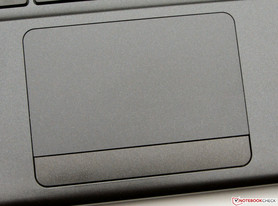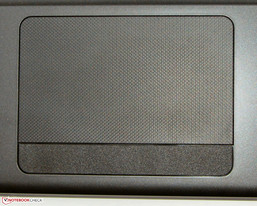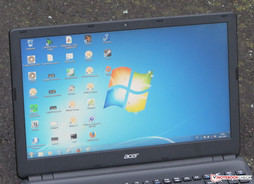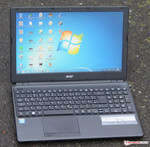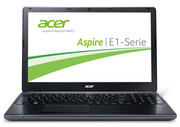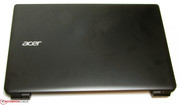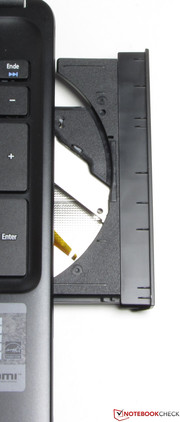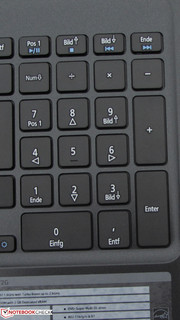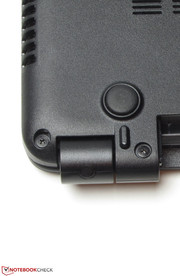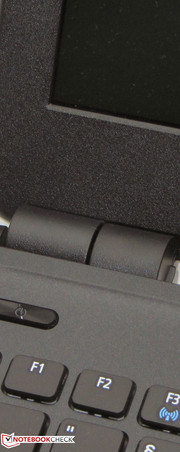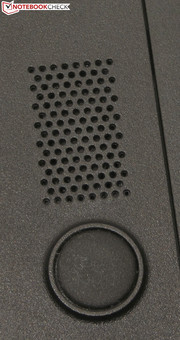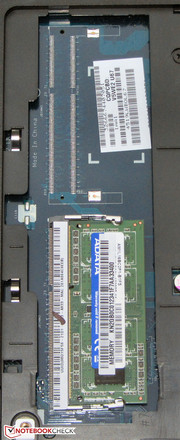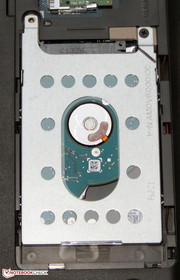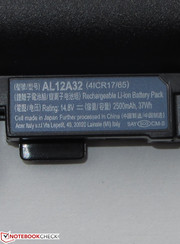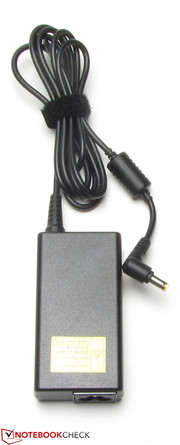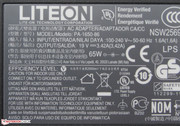Review Acer Aspire E1-532 Notebook

For the original German review, see here.
Acer is currently offering their 15.6-inch Aspire E1-532 office notebook for an incredibly low price -- starting at 250 Euros (~$345). The buyer will get a Haswell Celeron processor, a matte display and a 500 GB hard drive -- not half bad, from the sound of it. The computer is part of Acer's current Aspire E1 lineup. We've already reviewed 3 members of this series: The Aspire E1-572G (Core i5-4200U, Radeon HD 8750M), the Aspire E1-572 (Core i3-4010U, HD Graphics 4400) and the Aspire E1-522 (AMD A4-5000, Radeon HD 8330) All three scored a "Good" in our ratings. Can the Aspire E1-532 keep up with its siblings? Read on to find out.
We will use the Toshiba Satellite C50D-A-10E (AMD A4-5000, Radeon 8330) and the Asus F55A (Pentium B980, HD Graphics (Sandy Bridge)) to assess the Aspire E1-532 in relation to its competition.
Because the Aspire E1-532 is structurally identical to the E1-522, E1-572 and E1-572G, we will not expound on its case, connectivity, input devices or speakers at length. Please see our reviews of these other three notebooks for further information on these subjects.
Features
Operating System
The Aspire comes with Linpus Linux preinstalled; however, installing Windows is a breeze. On their website, Acer has Windows 8 and 8.1 drivers available for download. It's also possible to use Windows 7, as all the necessary drivers are accessible. We ran all our benchmarks on the notebook under Windows 7.
The computer comes with a driver DVD. Good: The drivers can be installed individually or en masse. Kudos to Acer for the fact that this DVD can also be used under Windows 7. Thanks to their provision, we had no problem installing the two current versions of Windows.
Maintenance
The maintenance hatch gives the user easy access to the computer's RAM and hard drive. Acer only equipped the E1-532 with one memory bank, and a 2 GB module comes preinstalled. Because the manufacturer chose not to provide the notebook with a second memory bank, one simple means of improving the system's performance is unavailable. With a second working memory module, the RAM would run in dual-channel mode. Dual-channel mode enables the computer to work the GPU to its full capacity, improving frame rates in video games by up to 20%. Switching out the hard drive is no problem. The slot fits 2.5-inch models at heights of 7 or 9.5 mm.
Input Devices
The Aspire and its Aspire E1 siblings all share the same keyboard and touchpad. The touchpad's surface, however, is a little different: Unlike the three other Aspire E1 computers, the E1-532's touchpad is visibly textured. There is no difference in functionality, however.
Display
Acer equips their Aspire with a matte 15.6-inch display. It has a native resolution of 1366x768 pixels and an average brightness of 217.6 cd/m². With these specs, this is a mid-range panel. The Satellite's display (218.1 cd/m²) is on par with the Aspire's. The F55A's display (239.8 cd/m²) offers a better number here. Both of the Aspire's competitors are outfitted with glossy screens.
| |||||||||||||||||||||||||
Brightness Distribution: 85 %
Center on Battery: 242 cd/m²
Contrast: 435:1 (Black: 0.55 cd/m²)
ΔE ColorChecker Calman: 7.57 | ∀{0.5-29.43 Ø4.78}
ΔE Greyscale Calman: 8.82 | ∀{0.09-98 Ø5}
41.3% AdobeRGB 1998 (Argyll 1.6.3 3D)
44.24% AdobeRGB 1998 (Argyll 3D)
63.4% sRGB (Argyll 3D)
42.77% Display P3 (Argyll 3D)
Gamma: 2.63
CCT: 10317 K
The panel's contrast (435:1) and black value (0.55 cd/m²) are reasonable. We've seen much more expensive notebooks with worse numbers here. With these results, the Aspire falls between the F55A (241:1, 1.08 cd/m²) and the Satellite (688:1, 0.33 cd/m²). The screen is not capable of covering the AdobeRGB or sRGB color spaces; it covers 57.2% of the sRGB color space and 42.3% of the AdobeRGB. Color space coverage is important for professional photo editing and the like.
Out of the factory, the display's average DeltaE 2000 deviation measures 7.6. Considering the notebook's price, this number isn't too bad. No color enters the target area (DeltaE less than 3). The display has a blue cast.
The Aspire is very well suited for outdoor use. Thanks to the display's matte surface, the user doesn't have to fit against light reflecting off the screen. Still, it's better to avoid trying to work in exceptionally bright environments.
The display's viewing angle stability is at the standard level for an inexpensive notebook. If you change the screen's vertical viewing angle, the image's colors quickly distort. Along the horizontal, the computer is more accommodating. The image is still visible from the side, though the screen does darken somewhat.
Performance
Acer's Aspire E1-532 is a very inexpensive 15.6-inch office notebook. The computer is built for everyday tasks; playing current video games is only possible to a limited extent. At the moment, the notebook is available starting at 250 Euros (~$345). Anyone who takes a liking to the computer, but wants more performance, should take a look at the structurally identical Aspire E1-572, Aspire E1-572G (with a dedicated Radeon HD 8750M graphics core) and Aspire E1-572P (with a touchscreen). All these models are equipped with stronger Intel processors (Core i3 to Core i7).
Processor
The Aspire runs on an Intel Celeron 2955U processor. The CPU is a brand new model from the Haswell generation. It runs at a speed of 1.4 GHz and has no turbo. This is an energy-saving ULV processor: Intel states a TDP of 15 watts. Together, its specs and price level are a clear indication that Intel intends for the Celeron to compete with APUs from AMD's E1, E2 and A4 lines.
The processor completes the Cinebench benchmark's CPU tests at a constant 1.4 GHz. The Satellite (AMD A4-5000, Radeon 8330) is outfitted with one of the Celeron's direct competitors from AMD. In terms of their performance, the two devices are tied. While the Aspire takes the lead in the single thread tests, the Satellite takes the prize in the multi-thread tests. Nevertheless, the Aspire has a clear advantage when it comes to everyday use, as single-thread performance is more important for daily tasks. All in all, the F55A (Pentium B980, HD Graphics (Sandy Bridge)) achieves the best results -- which isn't surprising. The F55A is equipped with a conventional mobile processor that runs at a considerably higher speed. The Aspire and the Satellite are tied in the GL tests too: In the Cinebench 10 GL tests the Aspire heads the race, whereas in the Cinebench R11.5 the Satellite finishes first.
System Performance
The computer almost always runs smoothly. The only exception is that when switching between several open applications, the user may experience a short delay. The relatively meager 2 GB of working memory is responsible for that problem. It certainly wouldn't hurt to switch out the preinstalled 2 GB module for a 4 or even 8 GB version. In the PCMark benchmarks, the Satellite (A4-5000, Radeon 8330) and the Aspire were basically on par with each other. The F55A (Pentium B980, HD Graphics (Sandy Bridge)) was able to rush a little further ahead, thanks to its stronger processor.
The computer's system performance can be significantly improved with the installation of a Solid State Drive. We tried equipping the notebook with an SSD (Crucial RealSSD C300 - 64 GB) and subsequently installed Windows 8 on the drive. Windows started more quickly, and the computer as a whole ran faster. The SSD also made a substantial difference in the PCMark benchmarks; the PCMark 7 result improved by 127% to 3371 points, and the PCMark Vantage result also climbed about 57% to 5500 points.
| PCMark Vantage Result | 3511 points | |
| PCMark 7 Score | 1484 points | |
Help | ||
Storage Solution
The Aspire is outfitted with a hard drive from the Seagate Momentus Thin series. It has a capacity of 500 GB and runs at 5400 rpm. The drive's transfer rates are completely respectable; CrystalDiskMark recorded a read speed of 102.5 MB/s, and HD Tune reported an average transfer rate of 86.4 MB/s.
Graphics Card
Intel's Haswell generation HD Graphics GPU is responsible for the notebook's graphics. It supports DirectX 11 and runs at speeds between 200 and 1000 MHz. The Satellite (A4-5000, Radeon 8330) and the Aspire are once again tied in the 3DMark benchmarks -- which computer has the lead flip-flops from one benchmark to the next. Intel successfully keeps up with the AMD GPU. Up until now, AMD GPUs have proven themselves superior to their Intel counterparts. The F55A (Pentium B980, HD Graphics (Sandy Bridge)) falls behind the other two competitors here.
The version of the HD Graphics GPU at work in the Aspire is the weakest current model. It runs at a maximum of 1 GHz and lacks dual-channel mode. Dual-channel mode works the GPU closer to its full capacity and improves benchmark results. The standard Pentium and Celeron class mobile processors - for instance the Pentium 3558U - are equipped with versions of the GPU with higher clock rates (1100 MHz). If you then add the performance increase that accompanies dual-channel mode, the graphics core should be on equal footing with comparable AMD cores.
| 3DMark 06 Standard Score | 3357 points | |
| 3DMark Vantage P Result | 2146 points | |
| 3DMark 11 Performance | 480 points | |
| 3DMark Ice Storm Standard Score | 22077 points | |
| 3DMark Cloud Gate Standard Score | 2169 points | |
| 3DMark Fire Strike Score | 300 points | |
Help | ||
| Acer Aspire E1-532 HD Graphics (Haswell), 2955U, Seagate Momentus Thin ST500LT0 12-9WS142 | Toshiba Satellite C50D-A-10E Radeon HD 8330, A4-5000, Toshiba MQ01ABF050 | Asus F55A-SX099D HD Graphics (Sandy Bridge), B980, Seagate Momentus Thin ST320LT020-9YG142 | |
|---|---|---|---|
| 3DMark 06 | |||
| 1280x1024 Standard Score AA:0x AF:0x (Points) | 3357 | 2942 -12% | 2597 -23% |
| 3DMark | 7% | ||
| 1280x720 Ice Storm Standard Score (Points) | 22077 | 25710 16% | |
| 1280x720 Cloud Gate Standard Score (Points) | 2169 | 2153 -1% | |
| 1920x1080 Fire Strike Score (Points) | 300 | 321 7% | |
| Total Average (Program / Settings) | -3% /
3% | -23% /
-23% |
Gaming Performance
The Aspire E1-532 was not conceived as a gaming notebook. Nevertheless, the computer manages to fluidly render a few current games at low resolution and low quality settings - for instance Grid 2 or StarCraft II: Heart of the Swarm. Less demanding games, like titles from the FIFA series, should also play fluidly at high resolution and high quality settings.
If you're interested in the Aspire and like what you see, but want to be able to play current video games on occasion, we recommend you take a look at the structurally identical Aspire E1-572G (Core i5-4200U, Radeon 8750M). The notebook fluidly renders most computer games. The version we reviewed is currently available starting at 460 Euros (~$635) - with a small hard drive (500 instead of 750 GB) and without a Windows operating system.
| low | med. | high | ultra | |
|---|---|---|---|---|
| The Elder Scrolls V: Skyrim (2011) | 21.7 | 11.2 | ||
| Anno 2070 (2011) | 36 | 16 | 9.8 | |
| Diablo III (2012) | 36.9 | 23 | 19.5 | |
| Hitman: Absolution (2012) | 12.3 | 9.9 | ||
| Dead Space 3 (2013) | 38.7 | 17.7 | 13.1 | |
| Tomb Raider (2013) | 30.3 | 14.3 | ||
| StarCraft II: Heart of the Swarm (2013) | 96.5 | 28.3 | 15 | |
| BioShock Infinite (2013) | 23 | 10.3 | ||
| GRID 2 (2013) | 38 | 19.6 | ||
| Saints Row IV (2013) | 14 | 7.8 | ||
| The Bureau: XCOM Declassified (2013) | 15.9 | 8.9 | ||
| Total War: Rome II (2013) | 22.4 | 16.9 | ||
| F1 2013 (2013) | 27 | 18 | 14 |
| Acer Aspire E1-532 HD Graphics (Haswell), 2955U, Seagate Momentus Thin ST500LT0 12-9WS142 | Toshiba Satellite C50D-A-10E Radeon HD 8330, A4-5000, Toshiba MQ01ABF050 | Asus F55A-SX099D HD Graphics (Sandy Bridge), B980, Seagate Momentus Thin ST320LT020-9YG142 | Acer Aspire E1-572G-54204G75Mnkk Radeon HD 8750M, 4200U, TOSHIBA MQ01ABD075 | |
|---|---|---|---|---|
| Anno 2070 | -4% | -40% | ||
| 1024x768 Low Preset (fps) | 36 | 33 -8% | 22 -39% | |
| 1366x768 Medium Preset AA:on (fps) | 16 | 15 -6% | 9.5 -41% | |
| 1366x768 High Preset AA:on AF:2x (fps) | 9.8 | 10 2% | ||
| GRID 2 | 132% | |||
| 1024x768 Ultra Low Preset (fps) | 38 | 74 95% | ||
| 1366x768 Medium Preset (fps) | 19.6 | 52.5 168% | ||
| Total Average (Program / Settings) | -4% /
-4% | -40% /
-40% | 132% /
132% |
Emissions
System Noise
In idle mode, the Aspire remains fairly quiet. The fan usually stands still, and the hard drive isn't audible. Here the sound pressure level measures 30.4 dB. The F55A (30.6 dB) is on par with our review device. The Satellite's numbers (31.3 to 31.6 dB) are a little higher. Under medium load (3DMark06 running) and full load (stress test, Prime95 and Furmark running), the Aspire's sound pressure level only rises to 31.8 and 33.3 dB respectively. The Satellite exceeds these measurements (33.5 and 35.9). The F55A proves to be substantially louder (40.1 and 42.2 dB). One ought not to forget, however, that the F55A is outfitted with a conventional mobile processor.
Noise level
| Idle |
| 30.4 / 30.4 / 30.4 dB(A) |
| HDD |
| 30.4 dB(A) |
| DVD |
| 35.3 / dB(A) |
| Load |
| 31.8 / 33.3 dB(A) |
 | ||
30 dB silent 40 dB(A) audible 50 dB(A) loud |
||
min: | ||
Temperature
None of the three devices ever reach problematic surface temperatures, neither in idle mode nor under load. Not a one crosses the 40 °C (104 °F) mark in a single area. This means all three devices can be safely placed on your lap anytime. The Satellite and the Aspire remain cooler overall than the F55A, as both are equipped with ULV hardware.
The Aspire behaves curiously in the stress test (Prime95 and Furmark running simultaneously for at least an hour): The CPU performs this test in AC power mode at 1.2 to 1.3 GHz. In battery mode, however, the processor works at full speed (1.4 GHz). The GPU behaves the same way. In AC power mode, it completes the stress test at 850 to 900 MHz, whereas it runs at 1000 MHz in battery mode. We ran this test over and over, always with the same results. Nevertheless, with everyday use the system's full computational power should always be available -- our benchmarks show that to be the case. The CPU temperature leveled off at about 50 °C (122 °F) in AC power mode.
(+) The maximum temperature on the upper side is 32.2 °C / 90 F, compared to the average of 34.3 °C / 94 F, ranging from 21.2 to 62.5 °C for the class Office.
(+) The bottom heats up to a maximum of 32.1 °C / 90 F, compared to the average of 36.8 °C / 98 F
(+) In idle usage, the average temperature for the upper side is 26 °C / 79 F, compared to the device average of 29.5 °C / 85 F.
(+) The palmrests and touchpad are cooler than skin temperature with a maximum of 31.7 °C / 89.1 F and are therefore cool to the touch.
(-) The average temperature of the palmrest area of similar devices was 27.6 °C / 81.7 F (-4.1 °C / -7.4 F).
Energy Management
Power Consumption
In idle mode, we measured a power consumption rate of between 5.9 and 8.1 watts. These numbers are reasonable. The Satellite needs a little more energy (4.9 to 10.8 watts). The F55A consumes too much (up to 16.2 watts). Under medium load (3DMark06 running) and full load (stress test, Prime95 and Furmark running), the Aspire's energy needs rose to 25.1 and 26.5 watts respectively. Here the Satellite proves to be the more frugal notebook (18.5 and 22.5 watts). The F55A again eats up the most energy (40.6 and 47.6 watts) -- its standard mobile processor is responsible for that shortcoming.
| Off / Standby | |
| Idle | |
| Load |
|
Key:
min: | |
Battery Life
In idle mode, the Aspire's battery keeps chugging along for 10:05 h. The Satellite (9:43 h) is on par with our review device here. The F55A gives up the ghost much earlier (6:15 h). We determine a device's battery life in idle mode using the Battery Eater Reader's test. The notebook's display brightness is regulated to the lowest setting, its energy-saving profile is activated, and its wireless modules are turned off. Under load, the Aspire holds out for 1:32 h. With that runtime, the computer lands between the F55A (1:11 h) and the Satellite (2:41 h). We establish a notebook's battery life under load with the Battery Eater Classic test. Here the display runs at full brightness, and the high-performance profile and wireless modules are activated.
The Aspire finished our WLAN test after 4:30 h. Once again, the notebook nestles in between the F55A (4:12 h) and the Satellite (7:08 h). In this test, we run a script that automatically loads a new website every 40 seconds. The energy-saving profile is active and the display brightness is set to about 150 cd/m². The E1-532 played a DVD for 4:04 h. This time it ran longer than both the Satellite (3:29 h) and the F55A (3:47 h). We execute the DVD test with the notebook's energy-saving profile activated (or a higher profile if the DVD doesn't play fluidly), its display at full brightness and its wireless modules deactivated.
All in all, the Aspire's battery runtimes are appealing. It doesn't surprise us that the Satellite runs the longest: Overall, it needs just as little energy as the Aspire, and it's also equipped with the largest capacity battery (Acer: 37 Wh, Toshiba: 48 Wh, Asus: 47 Wh).
Verdict
At a ticket price of around 250 Euros (~$345), you can't expect much of a notebook. Not only does the Aspire manage to avoid disappointing -- it even exceeds expectations. The device is equipped with enough computational power to perform everyday tasks easily. It can even handle the occasional current video game at low settings. The Aspire always runs quietly. It barely warms up, and it needs very little energy. We also like the notebook's matte display. Its various measurements (viewing angle stability, color display, etc.) are just average and it has a blue cast, but at this price level these weaknesses are acceptable. Many more expensive notebooks offer worse displays. The computer's battery runtimes are also completely respectable. Don't forget: Acer offers a two-year warranty. We didn't observe any serious flaws with the notebook. The only thing we consider worth mentioning here is the lack of a second working memory bank. Acer's choice here is probably related to the notebook's price.
The Asus F55A should be interesting to users seeking more CPU performance. The notebook is outfitted with a standard mobile processor that performs considerably higher than the competitors' CPUs. The Asus computer is no longer available in the version we tested -- now Asus is offering a version (the Asus X55A-SX174D; F55A and X55A are both part of the same series that Asus sells under two names) with a Pentium 2020M processor (Ivy Bridge). It currently costs 300 Euros (~$410). The Toshiba Satellite C50D-A-10E's only advantageous feature is its longer battery life in our WLAN test (which simulates normal everyday use). At a price of about 400 Euros (~$545), the Satellite is considerably more expensive than its competitors.




